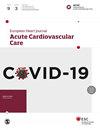感染性心内膜炎的微生物学检查结果、事件预测和预后价值
IF 3.9
2区 医学
Q1 CARDIAC & CARDIOVASCULAR SYSTEMS
European Heart Journal: Acute Cardiovascular Care
Pub Date : 2024-05-09
DOI:10.1093/ehjacc/zuae036.137
引用次数: 0
摘要
无。导言 在感染性心内膜炎中,微生物的分离与疾病的预后有关。确定心内膜炎的病因有助于决定进一步的适当治疗。我们的目的是评估在我们的医疗保健领域中最常见的微生物检查结果,以及它们与预后决定因素之间的关联。材料与方法 回顾性、观察性、单中心研究*。以一家心脏外科参考医院 2016-2022 年期间诊断为感染性心内膜炎患者的登记资料为基础。根据微生物分离类型对感染性心内膜炎患者进行分析,观察微生物流行病学,并根据基线特征(年龄、性别、风险因素)、各组不同的治疗管理(使用的抗生素治疗类型、手术干预、手术指征等)对各组进行比较,根据不同预后决定因素和事件(再感染、栓塞、休克、死亡率、局部并发症等)的频率对各组进行比较。为了分析不同微生物组间事件的差异,采用了同质性的奇平方统计,显著性水平为 p<0.05。结果 分析了 162 名患者,平均年龄为 66 岁。血液培养阳性率为 93%。最常分离出的微生物为:图 1。与其他类型的微生物分离患者相比,金黄色葡萄球菌心内膜炎患者(平均年龄也为 66±10 岁)的起搏器感染率更高,并发脓毒性休克的频率更高(43%,p<0.01)。不过,我们的手术率并不高,而且我们也没有观察到复发率或死亡率方面的显著差异,尽管这是一种毒性很强的微生物。另一方面,表皮葡萄球菌(与早期人工瓣膜心内膜炎有关)是与脓肿、瘘管或其他瓣周受累关系最密切的微生物(34%,P=0.04),与瓣膜手术后的心内膜炎有关。这组病原体似乎也更倾向于引起房室传导阻滞,尽管这种倾向并不明显。此外,表皮葡萄球菌是最常接受手术的一组患者(62% p<0.001)。结论 在本研究中,我们观察到费氏大肠杆菌的分离频率较高,与其他系列相比差异显著,而且与其他微生物相比,复发率明显较高。金黄色葡萄球菌是与休克关系最密切的微生物,但也是接受手术次数最少的微生物,尽管两者在人群中具有可比性。在人工瓣膜心内膜炎中,表皮葡萄球菌是最常分离到的病原体,而且更常与瓣周受累和手术需求相关。本文章由计算机程序翻译,如有差异,请以英文原文为准。
Microbiological findings in infective endocarditis, event predictor and prognostic value
Funding Acknowledgements None. Introduction In infective endocarditis, microbial isolation can be related to the prognosis of the disease. Identify the cause of endocarditis can help decide further management appropriate. Our purpose was to evaluate the most frequent microbiological findings in our healthcare area, as well as their association with prognostic determinants. Material and Methods Retrospective, observational, single-center study*. Based on a registry of patients diagnosed with infective endocarditis during the years 2016-2022 in a reference hospital with cardiac surgery. Patients with infective endocarditis were analyzed according to their type of microbial isolation, observing the microbial epidemiology and comparing these groups according to their baseline characteristics (age, sex, risk factors), the different therapeutic management in each group (type of antibiotic treatment used, surgical intervention, surgical indication etc.) and compared the groups according to the frequency of different prognostic determinants and events (Reinfection, Embolism, Shock, Mortality, local complications, etc.). To analyze the differences in events between different groups of microorganisms, the Chi square statistic of Homogeneity was used, and a significance level of p<0.05 was established. Results 162 patients were analyzed for an average of 66 years. The rate of positive blood cultures was 93%. The most frequently isolated microorganisms were, Figure 1. Patients who suffered from S. aureus endocarditis (with a mean age also of 66±10 years) had a higher prevalence of pacemaker infections and were complicated by septic shock more frequently (43%, p<0.01) than patients with other types of microorganism isolation. However, we did not have high surgery rates, and we did not observe significant differences in terms of recurrence or mortality, despite being a very virulent microorganism. On the other hand, S.Epidermidis (which is associated with early prosthetic valve endocarditis) is the microorganism most closely related with abscesses, fistulas or other perivalvular involvements (34%, p=0.04), in relation to endocarditis after valve surgery. This group also appears to have a greater tendency, although not significant, to cause AV blocks. Furthermore, S.Epidermidis was the group of patients that most frequently underwent surgery (62% p<0.001) Figure 2. Conclusions In this study, we have observed a higher frequency of isolation of E. feacalis, with significant differences in comparison to other series, and a significantly higher number of recurrences in comparison to other microorganisms. S. aureus is the microorganism most linked to shock, but it is also the one with the lowest number of undergone surgeries, despite being comparable populations. In valve prosthetic endocarditis, S. epidermidis was the most frequent pathogen isolated, and was more frequently associated with perivalvular involvement and the need for surgery.
求助全文
通过发布文献求助,成功后即可免费获取论文全文。
去求助
来源期刊

European Heart Journal: Acute Cardiovascular Care
Medicine-General Medicine
CiteScore
8.50
自引率
4.90%
发文量
325
期刊介绍:
The European Heart Journal - Acute Cardiovascular Care (EHJ-ACVC) offers a unique integrative approach by combining the expertise of the different sub specialties of cardiology, emergency and intensive care medicine in the management of patients with acute cardiovascular syndromes.
Reading through the journal, cardiologists and all other healthcare professionals can access continuous updates that may help them to improve the quality of care and the outcome for patients with acute cardiovascular diseases.
 求助内容:
求助内容: 应助结果提醒方式:
应助结果提醒方式:


